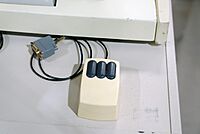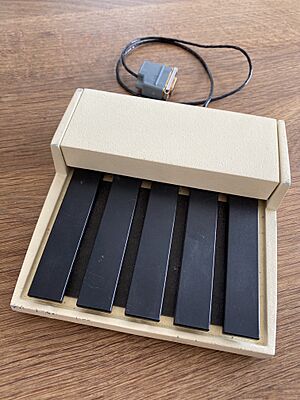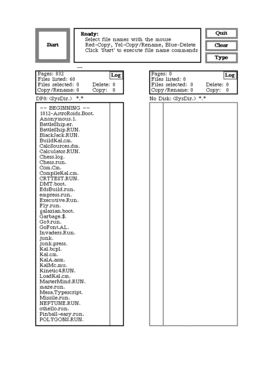Xerox Alto facts for kids

The Alto has a keyboard, mouse, and portrait-oriented monitor.
|
|
| Developer | Xerox PARC |
|---|---|
| Manufacturer | Xerox PARC |
| Release date | March 1, 1973 |
| Introductory price | US$32,000 (equivalent to $129,000 in 2022) |
| Units shipped | Alto I: 120 Alto II: 2,000 |
| Media | 2.5 MB one-platter disk cartridge |
| Operating system | Alto Executive (Exec) |
| CPU | TTL-based, with the ALU built around four 74181 MSI chips. It has user programmable microcode, uses big-endian format and a CPU clock of 5.88 MHz. |
| Memory | 96 – 512 KB (128 KB for $4000) |
| Display | 606 × 808 pixels |
| Input | Keyboard, 3-button mouse, 5-key chorded keyboard |
| Connectivity | Ethernet |
| Successor | Xerox Star |
| Related | ETH Lilith; Lisa; Apollo/Domain |
The Xerox Alto was a special computer system. It was created at Xerox PARC in the 1970s. Many people think it was one of the first workstations or personal computers. Its design helped create many parts of modern computers we use today.
The Alto had a graphical user interface (GUI). This means you could see pictures and icons on the screen, not just text. It also used a mouse to control things. It could connect to other computers using Ethernet networking. Plus, it could run many programs at the same time. It was also one of the first computers to use a WYSIWYG (What You See Is What You Get) text editor. This meant what you typed on the screen looked exactly like it would when printed.
The Alto was not sold to many people. But it had a huge impact on how future computers were made.
Contents
How the Alto Changed Computers
The Alto was designed for an operating system that used a GUI. This system later used the idea of a "desktop" on the screen. The first Alto machines came out on March 1, 1973. Xerox's ideas later inspired Apple to make the first popular computers with GUIs.
The Alto was a fairly small computer. It used a special central processing unit (CPU) made from many small parts. Each Alto cost tens of thousands of dollars. Not many were built at first. But by the late 1970s, about 1,000 were used at Xerox labs. Another 500 were used at different universities. In total, about 2,000 Alto systems were made.
The Alto became very famous in Silicon Valley. Its GUI was seen as the future of computing. In 1979, Steve Jobs visited Xerox PARC. His company, Apple Computer, saw how Xerox's technology worked. Apple engineers then used these ideas to create the Lisa and Macintosh computers.
In 1981, Xerox made a line of office computers called the Xerox Star. These were based on the Alto's ideas. A full office system with several computers and a laser printer cost up to $100,000. Like the Alto, the Star did not sell widely.
Alto's Development Story


The Alto was the first computer with a graphical operating system. Its design was based on earlier graphical ideas. The idea for the Alto came in 1972 from a memo by Butler Lampson. It was inspired by the oN-Line System (NLS). This system was made by Douglas Engelbart at SRI International. The PLATO education system also influenced the Alto.
Most of the Alto was designed by Charles P. Thacker. The actual building and design for factories was done by Xerox's Special Programs Group. An early set of 30 Altos was made. Because these worked well, the team went on to make about 2,000 units over the next ten years.
You can see several Xerox Alto computers today. They are on display at the Computer History Museum in California. One is at the Computer Museum of America in Georgia. Some are also owned by private collectors. Working Altos can be seen at the System Source Computer Museum in Maryland.
Charles P. Thacker won a big award, the 2009 Turing Award, for his work on the Alto. Other people like Alan C. Kay and Butler Lampson also won awards for their work on the Alto. In 2014, the Alto's source code (the instructions that make it work) was made public.
How the Alto Was Built
The Alto used a special design called "microcoded." This meant its basic instructions could be changed by programmers. This helped programs like Pinball run faster. The Alto had a special part called an arithmetic logic unit (ALU). It also had 128 KB of main memory. This could be expanded to 512 KB.
For storing large amounts of data, it used a hard disk drive. This drive used a removable 2.5 MB cartridge. The main computer and one disk drive were in a cabinet. It was about the size of a small refrigerator. You could add another disk drive by connecting it.
The Alto was different from other computers of its time. It did not have a separate central processing unit (CPU) that connected to memory. Instead, its ALU worked directly with the memory and other parts. This was controlled by special "microinstructions." The Alto could run up to 16 tasks at once. One task ran the normal programs. Other tasks handled the screen, disk, and network.
For example, the screen controller was very simple. The microcode moved data from memory to a special part. This part then turned the data into pixels on the screen. The Ethernet connection also used simple hardware. The microcode helped send and receive data. Its speed was 3 megabits per second. This speed allowed it to handle the screen, disk, and memory at the same time.
Alto's Unique Features
Unlike most minicomputers then, the Alto did not use a simple text screen. Its only common output was a black and white screen. This screen was tall, like a book page, not wide like a TV. Its input devices were a special keyboard and a three-button mouse. It also had an optional 5-key chorded keyboard. The mouse was very popular with Alto users. However, the chorded keyboard never caught on.
Early Alto mice had three narrow buttons. They were arranged one above the other. The mouse's movement was sensed by two wheels. These were soon replaced with a ball-type mouse. This new mouse was invented by Ronald E. Rider. It used light to count the rotations of wheels inside.
Each key on the Alto keyboard was a separate piece of information. This meant you could press many keys at once. This feature could even change how the Alto started up. Holding down specific keys could load different programs. This led to the funny term "nose boot." This was when you needed to press so many keys that you had to use your nose! Later, a program was made to make booting easier.
Other devices were also made for the Alto. These included a camera and a special printer. The Alto could also control outside disk drives. This allowed it to act as a file server, sharing files with other computers. This was a common use for the machine.
Programs and Software
Early programs for the Alto were written in a language called BCPL. Later, they used Mesa. Mesa was not widely used outside Xerox PARC. But it influenced many later programming languages. The Alto used an early version of ASCII code. It did not have the underscore character. Instead, it had a left-arrow character. This might be why the "CamelCase" style for naming things became popular. Users could also program the Alto's microcode.
The Alto helped make raster graphics popular. This is where all output, like text and pictures, is made of tiny dots. It also introduced the idea of "bit block transfer" (BitBLT). This was a basic way to program the screen. Even with its small memory, many new programs were made for the Alto. These included:
- The first WYSIWYG document programs, Bravo and Gypsy.
- Email tools like Laurel and Hardy.
- The Sil graphics editor for technical drawings.
- The Markup bitmap editor, an early paint program.
- The Draw program for lines and curves.
- The first WYSIWYG editor for designing computer chips.
- Early versions of the Smalltalk programming environment.
- Interlisp, another programming environment.
- One of the first online video games for many players, Alto Trek.
The Alto did not have spreadsheet or database programs. The first electronic spreadsheet, VisiCalc, came out later in 1979.
Alto's Influence and Legacy
The Alto was a small minicomputer. But it was like a personal computer because one person used it at a desk. This was different from the huge mainframe computers of that time. Some people say it was "the first personal computer." More importantly, it was one of the first workstation systems. Later workstations like the Apollo and Symbolics were influenced by it.
In 1976, a Swiss computer expert named Niklaus Wirth visited PARC. He was very impressed by the Alto. Since he couldn't take an Alto back to Europe, he decided to build a new system. He and his team designed the Lilith. It was ready around 1980. This was before Apple released the Lisa in 1981 and the Macintosh in 1984.
In 1978, Xerox gave 50 Altos to several universities. These included Massachusetts Institute of Technology and Stanford University. These machines inspired other computers like the ETH Zurich Lilith and the PERQ workstations. They also influenced the Stanford University Network (SUN) workstation. This led to the company Sun Microsystems. The Apollo/Domain workstation was also greatly influenced by the Alto.
In December 1979, Apple Computer co-founder Steve Jobs visited Xerox PARC. He saw the Smalltalk programming system and networking. Most importantly, he saw the WYSIWYG, mouse-driven graphical user interface of the Alto. He was very excited by the GUI. This GUI was quickly put into Apple's products. First, it was in the Lisa, then the Macintosh. Jobs also hired several important researchers from PARC.
In 1980-1981, engineers at PARC used Altos to design the Star workstations.
Xerox and the Alto's Future
Xerox was slow to understand how valuable the technology at PARC was. The company was not eager to get back into the computer business. This was because their earlier attempts had not sold well.
Byte magazine said in 1981:
It is unlikely that a person outside of the computer-science research community will ever be able to buy an Alto. They are not intended for commercial sale, but rather as development tools for Xerox, and so will not be mass-produced. What makes them worthy of mention is the fact that a large number of the personal computers of tomorrow will be designed with knowledge gained from the development of the Alto.
After the Alto, PARC made more powerful workstations. These were called "D-machines." They included Dandelion, Dolphin, and Dorado. Before personal computers like the Apple II (1977) and the IBM Personal Computer (1981), computers were very expensive. They were mainly mainframes and minicomputers. These used simple terminals that shared the main computer's power.
Through the 1970s, Xerox did not seem interested in PARC's work. When Xerox finally entered the personal computer market, they did not use the Alto design. Instead, they chose a very standard computer. It had a simple text screen and no mouse.
With help from PARC researchers, Xerox eventually made the Xerox Star. This was based on the Dandelion workstation. Later, they made a cheaper version called the 6085 office system. These machines used most of the Alto's new ideas. This included the graphical user interface with icons, windows, and folders. They also had Ethernet networking and laser printer services.
Xerox only realized its mistake in the early 1980s. This was after the Macintosh changed the computer market. The Macintosh had a screen with graphics and a mouse-centered interface. Both of these ideas came from the Alto. The Xerox Star series did sell somewhat well. But it came too late. The expensive Xerox workstations could not compete with cheaper GUI-based computers. These new computers came out after the first Macintosh. Xerox eventually left the workstation market.
See also
- NLS (computer system)
- Mousepad
- Alan Kay
- Adele Goldberg (computer scientist)
| Xerox Alto 1973–1975 (Alto I)
|
Succeeded by Xerox Star |



